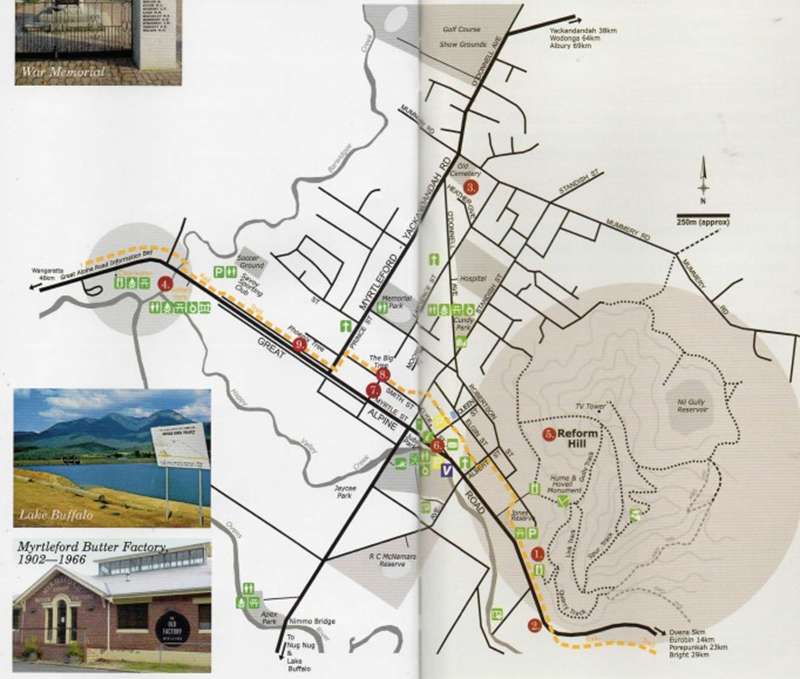Myrtleford - Places of Historical Interest

The most significant places of historic interest in Myrtleford and the surrounding area are:
1. Paul's Gold Crusher
The Buffalo Creek battery was driven by a huge waterwheel from the 1880s until 1936-37.
The Pauls
James and Elizabeth Paul, with their four children, set foot in Australia on Boxing Day, 1855... when the clipper RMS Schomberg struck a reef off Peterborough in south west Victoria, with 430 passengers and crew on board. All were rescued.
The family travelled to Beechworth in 1856, then arrived in Myrtle Creek Village (today's Myrtleford) in July 1857, one day after the anti-Chinese riots on the Buckland. James sold mining provisions from a store and operated the Myrtle Creek Hotel on the Buckland Road until 1874, when he moved to a farm on Buffalo River.
In 1878, James's and Elizabeth's eldest son Joseph established the 5-head gold battery on Buffalo Creek, powered by a huge water wheel. Water was later supplied by an 8km water race. This channel, dug by hand by members of the Paul family, carried diverted water from further up the Buffalo Creek valley.
The battery handled quartz for crushing from a wide area in the Buffalo River - Myrtleford area, and took on extra tonnages when the Reform Hill Battery was out of service. Crushings began to slow down in the 1920s and eventually ceased in 1937.
The Sawmill
The water power of the stamper mill was also harnessed to operate a saw mill on its original site. Later, the saw mill was detached and transported further up Buffalo Creek, where it operated as a steam-powered bush mill.
The Stamper Today
In the early 1970's the Buffalo Creek gold stamper was still standing, covered by blackberries. In the late 1970's the blackberries were burnt and the stamper collapsed. The metal parts were to be sold as scrap metal.
The Bienvenu family purchased the stamper in 1979 to preserve its heritage value. They moved the remaining parts to their Buffalo Creek property, using two tractors and a crude sled. Twenty five years later the stamper was donated for public display to ensure preservation.
2. Myrtleford Butter Factory
The factory opened in 1902 and became the central point for processing cream collected throughout the district, with production reaching a peak in the 1950s. Amalgamation created the Milford Co-op Dairy Co. in 1963 and butter production ceased in 1966.
3. Myrtleford Pioneer Cemetery
The cemetery was gazetted in 1860. Two thirds of the area is subdivided by religious denomination. Significant places for burials of infants and Chinese people are also memorialized.
4. Historical Tobacco Kiln

Built in 1957 by the Pizzini Bros. at Eurobin, this kiln is typical of those built in the 1930-60 era. A wood furnace and ventilation cured 500 sticks to yield 500 kg of cured tobacco leaf.
5. Reform Hill
The Reform Mine of 1856-88 and 1896-1906, was the most significant mine in the district. A Hume & Hovell Memorial was erected on the centenary of the arrival of the exploration party in November, 1924.
6. War Memorial
The war memorial was funded by public subscription and officially unveiled on Anzac Day, 1923. The precinct was named the A.D. Lowerson V.C. Memorial Square in 2012 and a bronze statue depicting Sgt. Lowerson's act of bravery was dedicated in 2015.
7. Soldiers Memorial Hall & Supper Rooms
After much local fundraising the Memorial Hall was officially opened in 1925 and became the main local venue for dances, fund raisers and movie screenings. A supper room was added in 1938.
8. The Big Tree
One of the oldest eucalypts in the district. In the vicinity of this tree the aboriginal inhabitants of the district are said to have congregated prior to and after the arrival of European overlanders in 1837. The railway station was also built in this vicinity in December, 1883.
9. The Phoenix Tree
Sculptured from a huge River Red Gum retrieved from the Barwidgee Creek, the sculpture was created by local Merriang artist, Hans Knorr (1915-88), with the assistance of local school children. It was officially dedicated in April, 1986.
10. Lake Buffalo
In May, 1965 a 33 metre high dam wall across the Buffalo River 20 km from Myrtleford was completed by the Victorian State Rivers & Water Supply Commission. This resulted in the creation of a water storage below the junction of the Yarrabulla Creek and Buffalo River.
Map of Places of Historical Interest in Myrtleford

Location
Great Alpine Road, Myrtleford 3737 View Map








